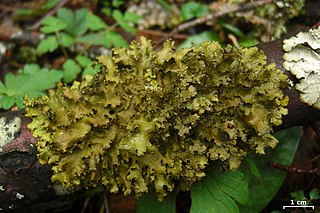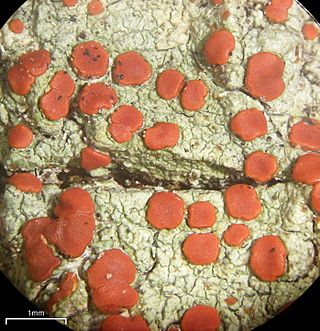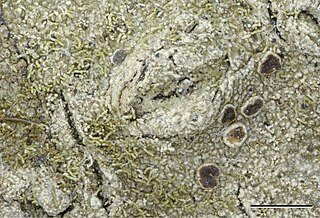
The Parmeliaceae is a large and diverse family of Lecanoromycetes. With over 2700 species in 71 genera, it is the largest family of lichen-forming fungi. The most speciose genera in the family are the well-known groups: Xanthoparmelia, Usnea, Parmotrema, and Hypotrachyna.

The Baeomycetales are an order of mostly lichen-forming fungi in the subclass Ostropomycetidae, in the class Lecanoromycetes. It contains 8 families, 33 genera and about 170 species. As a result of molecular phylogenetics research published in the late 2010s, several orders were folded into the Baeomycetales, resulting in a substantial increase in the number of taxa.

The Graphidaceae are a family of lichen-forming fungi in the order Graphidales. The family contains nearly a hundred genera and more than 2000 species. Although the family has a cosmopolitan distribution, most Graphidaceae species occur in tropical regions, and typically grow on bark.

Allocetraria is a genus of lichenized fungi in the family Parmeliaceae. It consists of 12 species, with a center of distribution in China.

Masonhalea is a genus of two species of lichenized fungi in the family Parmeliaceae.

Tuckermannopsis is a genus of foliose lichens in the family Parmeliaceae.

Melanelixia is a genus of foliose lichens in the family Parmeliaceae. It contains 15 Northern Hemisphere species that grow on bark or on wood. The genus is characterized by a pored or fenestrate epicortex, and the production of lecanoric acid as the primary chemical constituent of the medulla. Melanelixia was circumscribed in 2004 as a segregate of the related genus Melanelia.

Parmotrema is a genus of lichen belonging to the family Parmeliaceae. It is a large genus, containing an estimated 300 species, with a centre of diversity in subtropical regions of South America and the Pacific Islands.

Xanthoparmelia is a genus of foliose lichen in the family Parmeliaceae. Xanthoparmelia is synonymous with Almbornia, Neofuscelia, Chondropsis, Namakwa, Paraparmelia, and Xanthomaculina. This genus of lichen is commonly found in the United States, as well as Australia, New Zealand and Ecuador.

Ramboldia is a genus of lichen-forming fungi in the family Ramboldiaceae. The genus was circumscribed in 1994 by Gintaras Kantvilas and John Alan Elix. It was emended in 2008 by the inclusion of Pyrrhospora species containing the anthraquinone russulone in their apothecia and having a prosoplectenchymatous exciple. The family Ramboldiaceae was circumscribed in 2014 to contain the genus.
Aino Marjatta Henssen, was a German lichenologist and systematist. Her father, Gottfried Henssen, was a folklorist and her mother was Finnish.

Coccotrema is a genus of lichen-forming fungi. It is the type genus of the family Coccotremataceae, in the order Pertusariales. The genus contains 16 species.
Austromelanelixia is a genus of five species of foliose lichens in the family Parmeliaceae. All species are found in the Southern Hemisphere.

Neoprotoparmelia is a genus of crustose lichens that was created in 2018. It contains 24 tropical and subtropical species that mostly grow on bark. Neoprotoparmelia is in the subfamily Protoparmelioideae of the family Parmeliaceae, along with the morphologically similar genera Protoparmelia and Maronina.

Trichotheliaceae is a family of lichen-forming fungi in the order Gyalectales. The family was circumscribed by Friedrich von Schilling and Friedrich August Georg Bitter in 1927.

Trapeliaceae is a family of lichens in the order Baeomycetales. The family contains 12 genera and about 125 species.

Varicellaria is a genus of crustose lichens. It is the only genus in the family Varicellariaceae.
Gyalectaria is a genus of crustose lichens in the family Coccotremataceae. It has three species. The genus was circumscribed in 2010 by Imke Schmitt, Klaus Kalb and Helge Thorsten Lumbsch, with G. jamesii assigned as the type species. The three species transferred to the genus were originally placed in the large genus Pertusaria. Molecular phylogenetics showed that they belong to a lineage distinct from and unrelated to that genus, but with a sister group relationship to the genus Coccotrema. The genus name combines Gyalect- and -aria, taken from the generic name Pertusaria.
Neoprotoparmelia capitata is a species of corticolous (bark-dwelling) and crustose lichen in the family Parmeliaceae. It is found in eastern North America.
Aspiciliopsis is a genus of lichen-forming fungi in the family Trapeliaceae. It has two species, both of which occur in the Southern Hemisphere.














